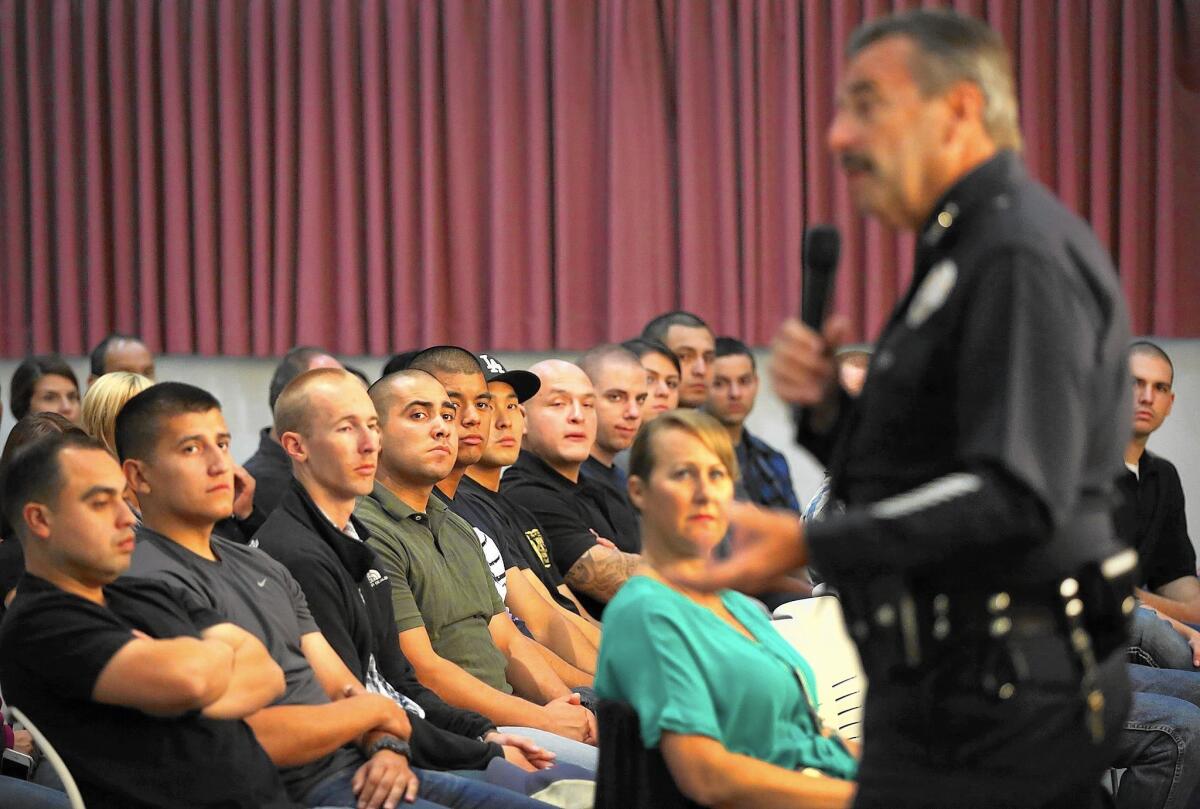LAPD urges officers to be community guardians, not warriors on crime

- Share via
For years, Los Angeles police officers have worked under the shadow of the department’s dark past.
The LAPD of the 1970s and ‘80s acted as a hard-charging, occupying force that raided poor neighborhoods and rounded up anyone in sight. Police stormed suspected crack houses, tearing down walls with a tank-like battering ram. Officers of that era were trained to think of themselves as soldiers in a never-ending war on crime.
But now the department is using that notorious history as a crucial lesson for its officers.
“We were warriors,” Deputy Chief Bill Scott recently told a room filled with LAPD rank-and-file officers, a group of fresh-faced rookies watching from the front.
Now, he said, officers need to think of themselves as guardians watching over communities — not warriors cracking down on them.
“That means if we’ve got to take somebody to jail, we’ll take them to jail,” Scott said. “But when we need to be empathetic and we need to be human, we’ve got to do that too.”
The message is one the LAPD is drilling into its officers in training that has been rolled out in recent weeks, part of a national movement to change law enforcement at a time when policing tactics are under increased public scrutiny.
Departments across the country are taking steps to replace the warrior mentality with a different approach, one that emphasizes protection over suppression, patience instead of zero tolerance. It’s a fundamental shift, one that could affect issues such as how often officers fire their guns and the way they walk down the street.
After decades of training that focused mostly on firearms and force, agencies from Seattle to New York are introducing what they call de-escalation training, which looks at ways officers can reduce tension and potentially avoid using force during encounters with the public.
The LAPD training comes as several police shootings have strained relationships that the department is carefully trying to cultivate with the same communities that bore the brunt of its old heavy-handed approach.
Some shootings, particularly those of black men, drew international attention, such as the March 1 killing of Charly Keunang in downtown’s skid row and the Venice death of Brendon Glenn two months later. The fatal police shooting of Ezell Ford in South Los Angeles last summer prompted protests that have continued a year after his death.
Mac Shorty, chairman of the Watts Neighborhood Council, said the department should have invited residents and local community leaders who have concerns about LAPD officers to the training. Doing so, he said, would have added legitimacy to the training.
He said many in his neighborhood have lost trust in the LAPD after the recent shootings, adding that he thinks twice before calling 911.
“Right now, the LAPD could never be the guardian of the community because there’s too much distrust,” he said. “Every time we get to the point we can trust them, there’s another shooting.”
The five-hour lectures in Los Angeles have covered matters such as the way officers should interact with people who are mentally ill, how they can build community trust, when they are permitted to curse while dealing with the public and why they should avoid walking with a swagger. Department brass emphasized that public perceptions of police can be influenced by the way officers treat residents during their daily work.
Scott warned one group assembled at a department pistol range that the brash attitudes some officers have — “I’m the cop, you’re not” — can appear disrespectful. “That’s one of the biggest problems that we have,” he said. “How we talk to people.”
In an Eastside auditorium, Deputy Chief Jose Perez told a crowd of Hollenbeck officers that just because department policy allowed them to curse at uncooperative suspects — the LAPD calls it “tactical language” — they shouldn’t automatically use foul language when walking up to someone.
“It doesn’t let you go up to them, when you’re getting out of the car, and you go: ‘Hey ... come here,’” Perez said, using a profanity. “We use it because we have to, not because you can or because you want to.”
When and how officers should use force was another key focus. Police were reminded to be patient with people who may be mentally ill and to try to build a dialogue in an effort to avoid using force to take them into custody.
In one session, officers were implored to carry less-lethal devices such as a Taser or beanbag shotgun in their patrol cars, so the option is always available. The department does not require all officers to carry less-lethal devices.
Officers watched videos from recent high-profile incidents, including one showing a South Carolina police officer fatally shooting Walter Scott in the back. Another showed a patrol car recording of the end of a police chase in Alabama in which five officers rushed to an unconscious man who had just been thrown from his van and began beating him.
“Wow,” one officer in the crowd said. Others rattled off what they felt the video showed: Ego. Adrenaline. Rage.
“Someone didn’t pull them from the back of the neck and tell them to knock it off,” Pacific Division Capt. Nicole Alberca said.
But it wasn’t always clear that the message sank in.
During another session, some Hollenbeck officers cracked jokes as they watched a video of San Bernardino County sheriff’s deputies repeatedly kicking and punching a suspected horse thief.
“That guy got tired,” one officer said of a deputy who left the fray.
“Poor horse,” said another.
“I hear all your guys’ comments,” Capt. Patricia Sandoval told the crowd. “Think about the guy that’s just sitting in front of his TV — has never been an officer, has never been in a fight — and he sees this. It just is very, very alarming.”
To quickly train thousands of rank-and-file officers, the department pulled entire divisions from the field at a time and scrambled to find venues large enough — one session was held in a high school auditorium, another was given in a movie theater.
The training included an introspective look at how the department policed Los Angeles decades ago, when frustration simmered, particularly among black residents who felt mistreated by officers. In some sessions, officers were shown one of the first grainy videos to put the spotlight on policing: the 1991 beating of Rodney G. King.
At a Westchester movie theater, Deputy Chief Bea Girmala recalled the chaos of the riots that came in 1992 after the officers who beat King were acquitted of assault charges. She and her partner spent days trying to quell the violence, she said, but when they tried to buy some coffee, a barista refused to serve them.
“We were so disdained by people, they didn’t even want to give us a cup of coffee,” she told her officers.
One by one, veteran officers shared their own memories of the riots: Feeling frustrated by command staff members who downplayed the severity of the situation. Writing phone numbers on their arms in case someone had to call their loved ones. Handing rifles to firefighters so they could cover the officers’ backs.
The message: Although it took several more years — and a few other scandals — the LAPD eventually realized the importance of engaging with the neighborhoods it policed.
Many officers said the training gave them a chance to reflect on the way they interact with the public. Some questioned the effect the sessions alone would have. The key, they said, was for the conversation to continue.
“It’s the kind of thing that, if people are taking it with them and thinking about what they heard today, that’s more impactful,” said Sgt. Shannon Enox, who works in the LAPD’s Southeast Division.
Seth Stoughton, a former police officer who teaches law at the University of South Carolina, said police departments are reacting to a public clamor for change after a series of high-profile police killings and other controversial incidents caught on video. Taking the time to rethink how police act, he said, is important in a profession that usually doesn’t afford the time for self-reflection.
“When you’re in the belly of the beast, when you’re wearing the boots and the gun belt, you don’t really think about the whys,” said Stoughton, who has written about what he calls “law enforcement’s warrior problem.” “You don’t really think about the big picture.”
But transforming law enforcement culture requires more than a few hours or days of de-escalation classes, he said.
“You also need some mechanisms in place to make sure that officers are applying what they learned,” he said.
The recent lectures are the first step, said Deputy Chief Bill Murphy, who oversees the LAPD’s training. Most of the officers have attended the lectures. This fall, the department is scheduled to roll out 10 hours of additional training in which officers will apply the de-escalation techniques to scenarios based on real-life encounters with the public.
“If they do everything right, there should be no force,” Murphy said. “If they don’t do everything right, then there will be some serious debriefing.”
Chief Charlie Beck said the training was more than a refresher course for rank-and-file officers. He said it was a valuable opportunity to talk to them about the issues that have emerged in the last year but also to look at the future of policing.
“This is not an issue that is just about other places. It’s about here too,” he said. “This is a milestone in the history of American policing that has to be recognized, and to allow this milestone to pass without having this discussion is not the wise thing to do.”
Twitter: @katemather
ALSO:
Woman’s killing throws Santa Maria into national immigration debate
Social media is reshaping policing and conversations about violence
Compton officials have been illegally inflating their pay, district attorney says
More to Read
Sign up for Essential California
The most important California stories and recommendations in your inbox every morning.
You may occasionally receive promotional content from the Los Angeles Times.











